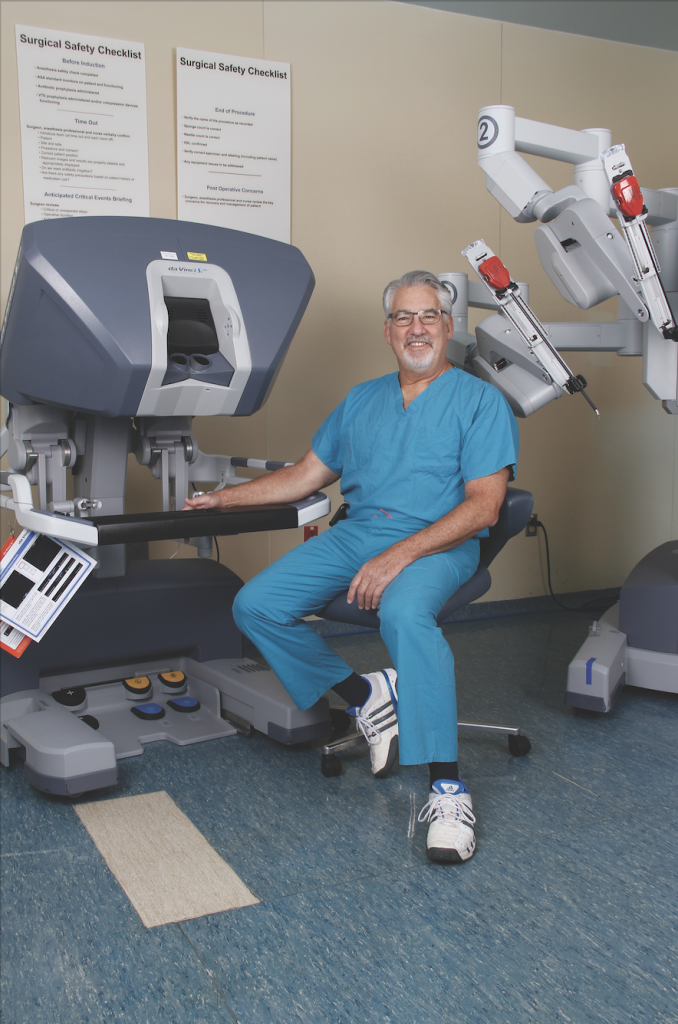
Hands
By Tiffany Schmidt
In 2008, Boone Hospital Center added a new technology to its repertoire, da Vinci, a robotic system that allows surgeons to perform surgeries with minute precision. These systems are operated through hand and foot controls that surgeons use to guide the slim robotic arms during procedures.
Since offering the da Vinci Surgical System as an alternative to traditional “open” surgery, Steven Dresner, MD has performed over 500 laparoscopic procedures alone. The majority of these surgeries have been radical prostatectomies, the removal of the prostate used to treat early or localized, aggressive prostate cancer, but other urologic surgeries on the kidney, bladder, ureter, adrenals, and lymph nodes can be done as well.
Boone also offers patients the option of robotic-assisted laparoscopic hysterectomies.
How does a surgeon perform a laparoscopic procedure?
Laparoscopic surgery is a minimally invasive technique. The procedures, which may be full-sized surgeries, are done through small puncture marks instead of large incisions. Small tubes fit into the punctures and small instruments fit through the tubes and accomplish the surgery. Full-sized surgery without the full-sized incision!
Robotic assistance takes laparoscopic surgery to the next level. The very small instruments have full range of movement, like a human wrist, and are controlled by a “robotic” or computerized link from the surgeon’s hands to the instrument, like a video game avatar.
In regular laparoscopic surgery, “what the surgeon controls with his hands are relatively simple tools that point straight forward, and they tweeze, cut, cauterize, or hold,” says Dr. Dresner. “The robotic instruments are wristed, meaning they move in four different degrees of freedom, so that when the surgeon puts his hands in the robotic console, every single movement the surgeon does with his hands in space is precisely imitated or replicated by the tiny little instruments inside the patient.”
This means that the robotic instruments can reach into places that can’t be reached with regular surgical instruments. Dr. Dresner explains that typical surgical instruments are great for places like high in the abdomen where there is plenty of space to work, but also surgeries down deep in the pelvis, underneath the pelvic bone. Closed-off spaces also greatly benefit from the increased mobility and agility that robotic assist can provide.
What’s the recovery time look like?
In addition to giving surgeons extra mobility in tight quarters, the laparoscopic camera provides a magnified view in three dimensions allowing for better visualization, meaning the surgery is more precise, with less blood loss and a more intricate repair. The recovery is drastically easier on the patient, taking about a third to a half of the time it would take to recover if there was an open incision.
Patients are typically in the hospital only one day, and are back to full activity in about a month, rather than two or three months. Patients also report much lower pain levels after surgery. Dr. Dresner has even had one patient go home the same day as the procedure.
“It is important to note that even though there is less blood loss and more precision, the doctors who perform open surgery will eventually see the same results, including rates of cancer control or cure,” says Dr. Dresner. “The recovery period, however, doesn’t really compare. Patients feel so much better so much faster with laparoscopic surgery.”